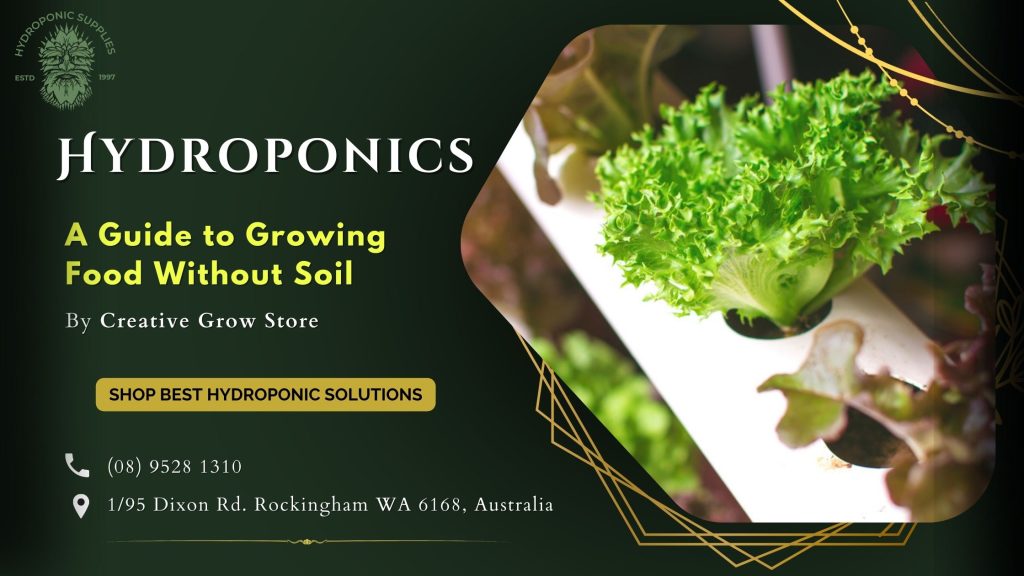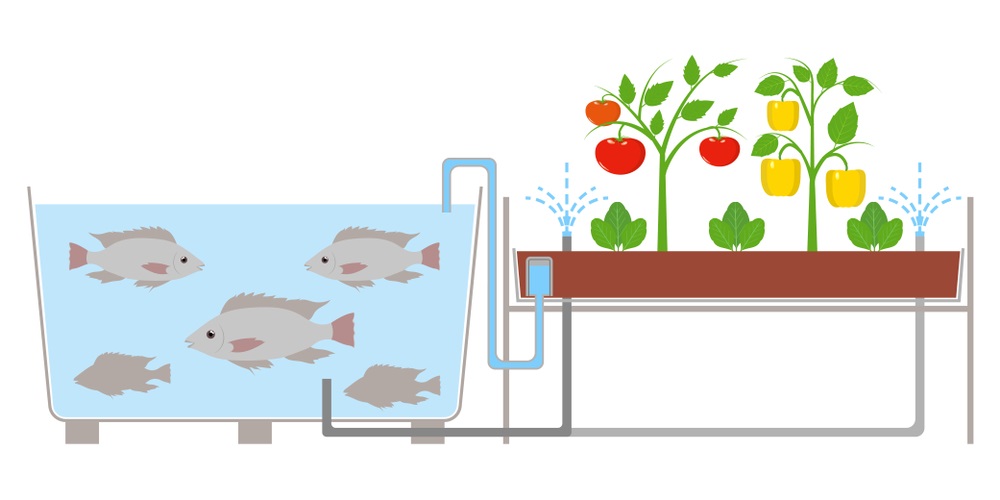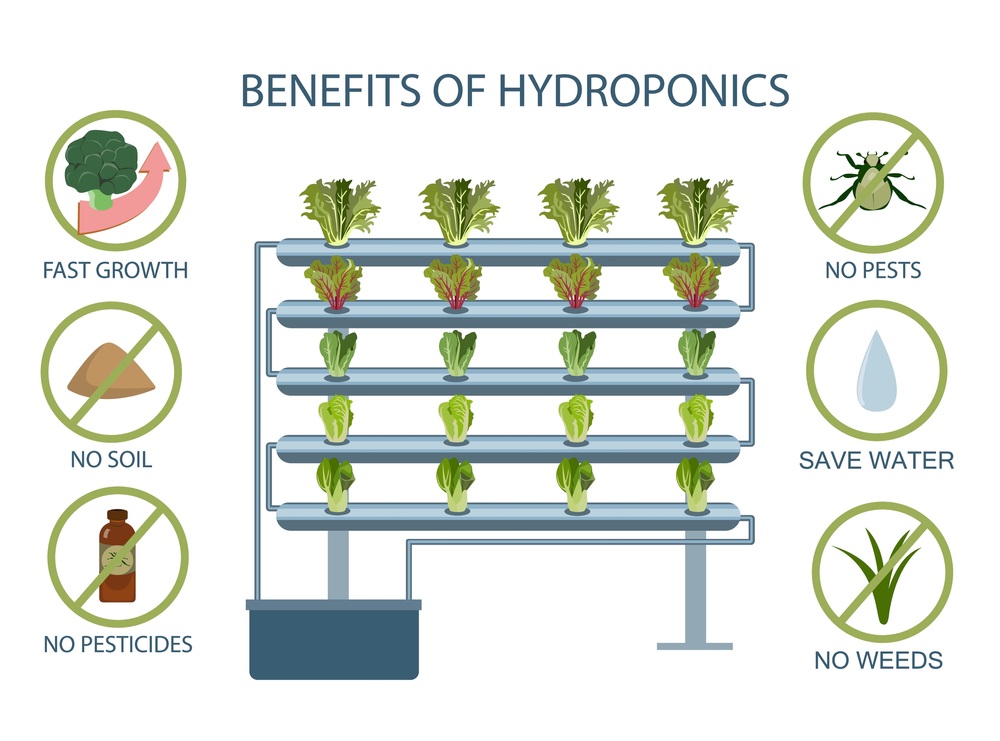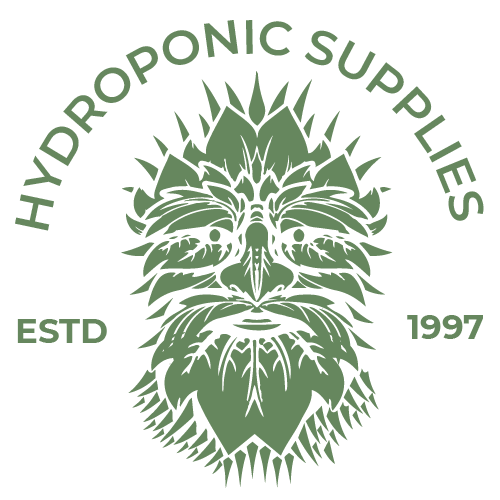
Wondering how you can grow fresh vegetables and herbs without soil?
Imagine growing your favorite fruits, vegetables, and herbs without the constraints of soil, while conserving water and maximizing space.
Here’s your welcome to the future of gardening – Hydroponics!
Hydroponic farming is a game-changer for anyone who loves fresh veggies but doesn’t have a big backyard. So, whether you’re growing basil for your homemade pizza or dreaming of juicy tomatoes all year round, hydroponics makes it possible, no green thumb required!
In this blog, Creative Grow Store introduces you to the artof growing food without soil – a hydroponic system that provides plants with precisely what they need to flourish.
So, get ready to explore the world of hydroponics and discover the endless possibilities of growing food in a soil-free environment!
What is Hydroponics?
Hydroponics comes from the Greek word “hydro,” meaning water, and “ponos,” meaning labor.
Hydroponics definition:
“Hydroponics is a modern gardening technique that involves growing plants and crops without soil by nourishing them directly with a nutrient-rich water solution in an artificial environment”.
In this soilless gardening technique, plant roots are suspended in water, which is enriched with nutrients that would otherwise come from the soil and its organic matter. In other words, instead of relying on the Earth for nutrients, hydroponic growing systems use water enriched with all the good stuff plants need to thrive.
It’s like creating a spa day for your plants, where they get pampered with essential nutrients, oxygen, and optimal growing conditions, resulting in faster growth and higher yields.
Unlike the traditional soil-based method, hydroponic approach is a viable option to reliably grow fruits, vegetables and herbs, regardless of climate, soil availability or space. Additionally, it’s super water-efficient that uses up to 90% less water than traditional methods.
How Do Hydroponics Work?
Hydroponics is like the high-tech magic of gardening; growing food hydroponically. So, what is hydroponically?Simply defining, it’s making plants flourish without soil!
Let’s explore how does this magic actually work!

It involves a tank or grow tray filled with water, in which plant roots are suspended, soaking up the good stuff directly from the water. But it’s not just plain water – it’s a rich mixture of carbon, oxygen, nitrogen, and other important nutrients that plants need to grow happy and healthy. Think of it as ‘hydro for plants’ – providingnutrient-rich water directly to them; a special cocktail for plants, customized to their exact needs.
Hydroponic farmers have lines and systems in place to constantly monitor and adjust the water’s composition, ensuring that plants get everything they need in the perfect balance. And you know the cool thing? In hydroponic systems, plants can grow up to 30% faster than those in soil. It’s like they’re on turbo mode, thanks to the optimized environment and direct access to nutrients.
Now, you might wonder, “Where does all this magic happen?” Well, it can happen anywhere – in your backyard, on your rooftop, or even inside your home. That’s because hydroponic systems are super adaptable and can fit into small spaces.
Now, let’s talk about Aquaponics – the fancy cousin of hydroponics.

In aquaponic systems, fish join the party. Their water from the tanks is cycled into the growing tanks, where their waste acts as a natural fertilizer for the plants. Thus, fishes help provide nutrients to the plants, and in return, plants clean and filter the water for the fishes.
Of course, managing an aquaponic system is a bit of a balancing act. You’ve got to make sure the fish are happy, the plants are thriving, and the water quality stays just right. But when it’s done well, aquaponics creates a self-sustaining ecosystem that’s efficient and eco-friendly.
Hydroponic Grow System | Common Types
Hydroponic systems can be categorized into two main types based on the method of supporting plant roots:
- Water-Culture Systems
- Medium-Culture Systems
Each type offers different approaches to growing plants hydroponically, catering to various needs and preferences.
- Water-Culture Hydroponic Systems
Water-culture systems rely only on the nutrient solution to support plant roots, without using any solid substrate. Here are four common methods of water-culture systems:
1. Nutrient Film Technique System (NFT)
In this method, plant roots are placed or suspended in a narrow grow tray or PVC tube where a flow of nutrient solution continuously passes over them, creating a thin film of water. NFT systems can be open, where the solution is not recycled, or closed, where excess solution is recovered and reused.
2. Deep Water Culture Systems (DWC)
In DWC systems, plant roots are suspended in a nutrient-rich water solution. Oxygen is provided through bubblers or air pumps to make sure the roots have received enough oxygen. This method is simple, cost-effective, and suitable for growing leafy greens and herbs.
3. Aeroponic Systems
In aeroponics, plants are placed in a support container where their roots are suspended in the air. Nutrient solution is misted onto the roots instead of immersing or dipping them in water. This system can be open or closed, providing optimal nutrient uptake and oxygenation for plants.
4. Raft or Floating System
Plants are supported on sheets of Styrofoam floating on aerated nutrient solution. The roots hang through holes in the Styrofoam and absorb nutrients from the solution. Raft systems are closed, requiring regular monitoring and adjustment of the nutrient solution.
- Medium-Culture Hydroponic Systems
Medium-culture systems utilize a solid substrate, such as sand or porous medium, to support plant roots. Here are three common methods of medium-culture systems:
1. Wicking System
Wick systems use an absorbent material or wick to draw nutrient solution to the plant roots from a reservoir. It’s a simple method with low-maintenance, often used for growing herbs, lettuce, and small flowering plants. But might be less suitable for larger or high-demanding plants.
2. Drip System
In this system, nutrient solution is transported to the plants through a drip irrigation in a solid medium. It involves variations like the tower garden use vertical PVC pipes filled with a porous medium, with nutrient solution applied from the top through drip emitters. Drip systems can be open, discarding excess solution, or closed, recycling the solution.
3. Ebb & Flow System
Nutrient solution is driven from a reservoir into a grow bed, flowing the medium where plants are rooted. Then, the solution flows back to the reservoir through gravity, creating a closed system where nutrients are recycled.
4. Subirrigation system
Here, plants grow in a porous medium, and nutrient solution is delivered to their roots through capillary action. This system ensures consistent moisture and nutrient availability, making it suitable for various plant types.
Benefits of Hydroponics

- No Soil Needed: Hydroponics lets plants grow without soil, which means you can grow plants even if you don’t have a big backyard or garden.
- No Pesticides/Harmful Chemical: Because hydroponic systems are controlled environments, you don’t need to use harmful pesticides to keep bugs away from your plants.
- No Weeds: Say goodbye to pulling out pesky weeds! Hydroponics eliminates the need for weeding, saving you time and effort.
- Saves Water: Hydroponic systems use way less water, up to 90% less than traditional gardening methods. This helps save water, which is super important for our planet.
- Grow Anywhere, Anytime: With hydroponics, you can grow plants all year round, no matter the weather or season. It’s like having your own mini garden indoors!
- Better Control on Crops: You have more control over how your plants grow in hydroponics, which means you can get bigger harvests and see your plants grow faster.
- Space-Efficient: Hydroponics lets you grow plants close together and stack them vertically, making the most of small spaces like balconies or indoor areas.
- Involves Reusable Materials: Many things used in hydroponics can be reused, like containers and nutrient solutions. This helps reduce waste and is good for the environment.
- No Crop Rotation Needed: Unlike traditional gardening, hydroponics doesn’t need you to rotate crops. This saves time and makes growing plants easier.
- No Pests: Because hydroponic systems are closed and controlled, pests have a harder time getting to your plants, so you don’t have to worry about them as much.
Limitations of hydroponics
- High initial cost due to special equipment needed.
- Requires technical knowledge about nutrients and pH.
- Prone to system failures like pump malfunctions.
- Depends on electricity that increases energy costs.
Growing Crops Hydroponically
Growing crops hydroponically is a trendy way to grow fresh produce, and you don’t need a big farm for it. Whether you’re at home, in an apartment, or even at the office, you can set up a hydroponic system.
Here are the six things you need to grow your hydroponic vegetable garden:
- Light: Plants need about five to six hours of light each day, whether from sunlight or artificial sources.
- Air: Make sure there’s good airflow around your plants to keep them healthy.
- Water: Instead of soil, plants are nourished by a nutrient-rich water solution.
- Nutrients: The water solution includes all the essential nutrients plants need to grow.
- Heat: Plants thrive in optimal temperatures, which vary depending on the plant type.
- Space: You’ll need a level area without too much wind for your hydroponic setup.
Choosing Common Plants for Hydroponic Growth
Not all plants are well-suited for hydroponic cultivation, so it’s essential to choose varieties that thrive in soil-free environments. Here are some popular plants that can be grown hydroponically:
- Leafy Greens: Like lettuce, spinach, kale, and Swiss chard, which grow fast and have shallow roots.
- Herbs: Basil, cilantro, parsley, mint, and chives are perfect for hydroponic setups and add fresh flavors to your meals.
- Tomatoes: You can grow cherry tomatoes or vine tomatoes using trellis systems for support.
- Strawberries: Try hydroponic towers or NFT systems for sweet and juicy strawberries.
- Peppers: Bell peppers and chili peppers thrive in hydroponic environments, giving you a continuous harvest of colorful peppers.
Setting Up a Hydroponic System | 8 Easy Steps
Here’s a simplified guide to setting up a hydroponic system:
Step #1: Choose the Right System
Select a hydroponic system that matches your space and the plants you want to grow. You can pick from options like Deep Water Culture (DWC), Nutrient Film Technique (NFT), Ebb and Flow, Drip Systems, or Aeroponics.
Step #2: Set Up the Containers
Put your containers where you want your plants to grow. Make sure they’re clean and have holes for water to drain if necessary.
Step #3: Mix Nutrient Solution
Make a balanced mix of nutrients for your plants. This mix should have important nutrients like nitrogen, phosphorus, potassium, calcium, magnesium, and iron.
Step #4: Place Your Plants
Carefully put your plants in the containers so their roots can soak in the nutrient solution. Adjust the water level if needed.
Step #5: Set Up Lighting
Ensure your plants get plenty of light. You can use sunlight or special grow lights. Change the brightness and how long the lights stay on based on what your plants need.
Step #6: Check pH and Nutrient Levels
Keep an eye on the pH of your nutrient mix. It should be just right for your plants to take in the nutrients well. Also, regularly check the nutrient levels and add more if needed to prevent shortages.
Step #7: Control Temperature and Humidity
Keep a steady temperature and humidity in your hydroponic area. Good air circulation helps stop mold and fungus from growing and harming your plants.
Step #8: Monitor and Adjust
Check on your plants often to make sure they’re getting enough water and nutrients. Change the water level and nutrient mix as needed.
Ready to start your hydroponic journey?
Call Creative Grow Store | Get the Best Hydroponic System Supplies Today!
Top of Form
At Creative Grow Store, we offer the best hydroponic solutions and expert advice for growing fresh, healthy food without soil.
Our expert team will guide you every step of the way to ensure your hydroponic garden thrives. Let’s discover the future of gardening together!
